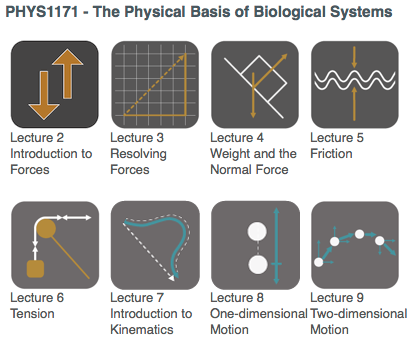Teaching
I teach courses across a range of years. I also have interests in teaching development and the scholarship of teaching.
Recent classes
I teach sections of PHYS1171 - The Physical Basis of Biological Systems. This course runs in each each semester and typically has 200 - 300 students. The course is algebra based and is designed for students continuing on in science but outside physics. Lectures are interactive and consist of discussion, "clicker" (electronic feedback) questions and problem solving.
I also teach PHYS2055 - Introduction to Fields in Physics. This is a core second year course and covers fields of various types including electromagnetism. We also cover aspects of physical optics.
Five Minute Physics
We ask students to prepare for lectures by reading core content usually from a prescribed textbook. Experience has shown that this approach meets with mixed success. In place of the textbook we are exploring using on-line modules. We prepare text and images covering the content of each lecture. To this we add features such as interactive simulations, short videos and quick check questions with immediate feedback.
Surveys and access statistics have shown this to be an effective approach for both first year and second year classes. The available modules can be viewed on the Five Minute Physics website.
Teaching Physics using Virtual Reality
Virtual reality offers the possibility of exploring environments not encountered in our everyday life. When travelling at speeds approaching the speed of light, weird phenomena such as length contraction and time dilation occur. In collaboration with researchers at the Australian National University, we developed and tested a virtual world showing these effects and associated teaching material. The simulation was used as part of our first year teaching laboratories and allowed students to explore and explain some of the weirdnesses that are observed. Visit the web page to find out more.
Laboratory Development
Participation in laboratory experiments is an important part of any physics program (even for theorists). I have been involved in the development of laboratory experiments across many courses. Some examples include
- First year core laboratories. We have revised the structure of the laboratory component of the course to include explorative laboratories that are closely linked to the course syllabus (and performed at the same team as the material is taught in lectures)
- Inquiry-based laboratory. We have developed an inquiry-based laboratory experiment examining heat transfer in houses and animals. Students must design and construct their own "house" or "animal" and test its thermal capabilities over a 24 hour period.
- Advanced laboratories. We have upgraded second and third year laboratory space and laboratory experiments to better couple with associated lectures. All students completing a major in physics at UQ attend these laboratories.
Textbook support material
We have developed textbook support material for the text we use in PHYS1171. This has included advisory material for teaching staff, worksheets for tutorial work and question banks of multiple choice and short answer questions. This material is made available by the publisher to course instructors adopting the textbook.
